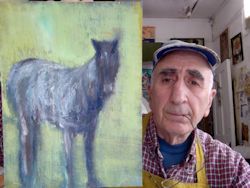Attached are three sloppy life studies sloshed on paperboard with cheap acrylics
in a race against the clock at Merritt College a few days ago.
Plus an acrylic on paper by my cousin Archie1 in the
year before he died, when he was 85, probably with one of his old Playboys or
Penthouses instead of a model. I try to imitate him though I’ll never succeed,
especially since I paint only once a week nowadays and it will take me another 85 years to
reach his expertise and knowledge.
He had to quit oils after his sister complained, but he used his acrylics in the
same way, quick and delicate like watercolor, combining his love of landscape with
his love of the nude, just as I want to do, though I don’t plein air
anymore except when my friend Alphonso calls me, which he hasn’t for several
months now.
As you can see, my own acrylics are crude, and here in the originals, which you
can’t see, the acrylic is in globs like kindergarten finger painting.
The cost of paint is partly why I think of quitting; after all, those thousands
of dollars will go into the garbage when I die, yet what else am I going to do before
then? Others get paid for their work while I have to pay for mine, but that’s what
the game is all about when you’re an amateur.
And so, when I found the life study at Merritt, I thought I could get by with the
cheap jars from Blick, but they were so gooey I had to slosh it like kindergarten,
and in the one with the model’s arm foreshortened (her right in the original),
you can see I didn’t have enough time to make her hand more than a glob and her
nose a smudge.
Smudges and globs are okay, as Archie would say, when you know how
to integrate them into a “totality” like de Kooning, and Picasso himself
in his own kindergarten gargoyles of his last nudes, but as you can see, I failed again.
Yet comparing my work with the masters has always been one of my best ways of learning,
and imitating them still keeps me going even though I’ll never reach them. After
all, they got me into this game in the first place. “Love Genius,” Blake said,
and imitating it is one of the best guides along the way.
In the meantime, the model was K.B., who began modeling around the same time I started
thirty years ago, and I’ve painted and sculpted her many times since then. She’s
nothing like my studies, of course; she’s actually a very sweet woman from Haiti
who came to Oberlin on a scholarship when she was a teen and then got her M.A. with
her expertise in French and Creole.
I love painting female models. I’m a sexist, yes, with no interest in male models,
but I’m in great company with Matisse and Degas and a host of others, though unlike
them I can’t afford one for as long as I want; and so I must rely on life classes
where I have to race against the clock. You have to try it yourself to know what
I really mean. There’s nothing like the thrill of painting a model and feeling the
old wave up the spine as the clock keeps ticking.
But then comes the result, which is always a failure, and you’re like the addict
who must have more and more until the final overdose.
Footnote:
- Arthur A. (Art) Pinajian (28 March 1914–18 August 1999):
was an Armenian-American
artist and comic book creator for Atlas/Marvel in the 1950s. He painted thousands of
portraits, landscapes, and abstracts as well, which are attracting growing attention.
(See
Wikipedia
for additional details.)
Back to commentary...
Notes from the Webmaster: |
-
Paintings in Garage Find Appreciation in Gallery
“Oh, just put it all in the garbage,” she told him. “He said
himself to just leave it all for the garbagemen.”
This article by James Barron describes how author/artist Peter Najarian
rescued thousands of paintings by his deceased cousin, Arthur Pinajian, which
were later valued at $30 million (New York Times, 8 Mar 2013).
-
-
To see more of Najarian’s paintings, and a series of his animal sculptures,
visit
his gallery at Photobucket.
|
| |
Dear Gatz,
That’s how Najarian began a recent letter to his friend, William Hjortsberg,
whose novel Falling Angel was the basis for the film Angel Heart.
The sketch by Najarian that appears on the Contents
page of SHJ-9 depicts Hjortsberg reading from Jubilee Hitchhiker: The
Life and Times of Richard Brautigan, at City Lights Bookstore in March of 2012,
“...the year the world was supposed to end,” as Najarian wrote to
“Gatz.”
|
grew up in New Jersey and now lives in Berkeley, California. His painting and writing
appear in a range of anthologies, journals, and galleries. He has received a Stegner
Fellowship and an NEA grant for Creative Nonfiction.
 Peter Najarian with oil painting of horse (November 2013)
Peter Najarian with oil painting of horse (November 2013)
|
He is the author of three novels, Voyages (Pantheon, 1971; reprinted by Ararat,
1979), Daughters of Memory (1986), and Wash Me on Home, Mama (1978);
a story collection, The Great American Loneliness (Blue Crane Books, 2000);
and a memoir, The Artist and His Mother (The Press at CSU Fresno, 2010).
The memoir is the first in a triptych of books. The second, The Artist and His
Models, includes illustrations by Najarian and is available for publication. The third
of the triptych, Pinajian by Najarian, is now with a small-press publisher in London,
due for release in the coming year.